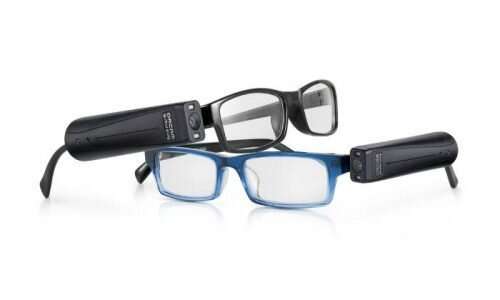January 11, 2020 weblog
Glasses talk, ears focus, in OrCam's tech showcase

OrCam Technologies at this year's CES made a name for itself as solutions bearer for wearable assistive technology. They have developed wearable aides for hearing and for reading. These make use of computer vision and machine learning technologies.
Prof. Amnon Shashua, OrCam Technologies Co-founder and Co-CEO, talked of "wearable, personal AI" and "AI as a companion."
First, there is OrCam's vision device called OrCam MyEye 2. TechCrunch described the OrCam MyEye 2 as a tiny device "for people with visual impairment that you clip on your glasses to help you navigate the world around you."
It has features that include the identification of consumer products, colors and money notes, said The Jerusalem Post, which described it as the size of a finger. It involves interactive reading/natural language processing as well as orientation (mobility and object identification, said the article.
The technology is aimed at people who (1) have reading difficulties or those with dyslexia, or (2) people who need to read large amounts of text, said The Times of Israel.
No smartphone needed; neither is WiFi. "The MyEye 2 is activated by an intuitive pointing gesture or simply by following the wearer's gaze," said Solomon.
The device attaches magnetically to the frame of glasses. A miniature camera serves to analyze visual data into an audio description. Hand gestures and buttons for activation get it to work. You can even adjust the reading volume and speed. There is an option to use earphones connected via Bluetooth for more privacy.
The device helps guide a person with vision difficulties... say, "what's in front of me?" and the device could tell you, for example, that there was a door.
MyEye 2 was among TIME magazine's Best Inventions for 2019.-The title of the write-up was "Vision Made Audible."
OrCam Hear, for those with hearing impairments, was showcased as a hearing-aid addition that smartens the aids. OrCam Hear can assist the wearer by "identifying and isolating a speaker's voice—from among multiple speakers—and then relaying the clear speech to Bluetooth hearing aids, in real time," said The Jerusalem Post.
The device is worn on clothing .
Shoshanna Solomon, The Times of Israel: A tiny camera is wirelessly connected to the hearing aid or earphones. The device discerns who is speaking to the user and it reads the person's lips. That speaker's voice is separated from those of other speakers and sources of noise. Not only that; the device switches between speakers when the focus shifts to another.
The Jerusalem Post: "The device combines lip reading with simultaneous voice source separation, intuitively switching between speakers who you choose to hear."
The other debut entry is called OrCam MyMe and it is for facial recognition, acting a personal assistant would, to tell the user about the person to meet with, via an app on a smartphone or smartwatch. OrCam MyMe detects faces and matches them to stored signatures for future instant recognition. The on-board camera acts as a sensor. No photos are stored. Once the photos taken are processed for face and object recognition, they are deleted. The Jerusalem Post said "all data is processed offline and stored on the device itself."
OrCam MyMe is for professional networkers to leverage the ability of 'never forgetting a face.' The device recognizes colleagues, clients, and business contacts, tells you when you last saw them and in what context.
Dillet in TechCrunch, meanwhile, reported that OrCam was introducing the OrCam Read, an AI reader. This is a handheld. You point it at text. The company said it could be particularly useful for people who have reading difficulties due to dyslexia," he wrote.
Ben Coxworth in New Atlas told readers just how the pen-sized tool works. OrCam Read "utilizes integrated lasers to highlight sections of either printed or onscreen text. It then reads that text aloud, with a built-in LED providing its camera with illumination in dimly-lit environments."
(Abrar Al-Heet in CNET: With dyslexia, "most struggle to identify speech sounds in a word or understand how letters represent those sounds. It's not clear what the causes of dyslexia are, though studies have shown there are differences in the way that the brains of people with dyslexia function and develop.")
More information: www.orcam.com/en/
© 2020 Science X Network


















